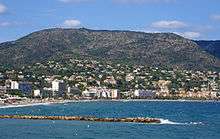Massif des Maures
The Massif des Maures ([ma.sif de moʁ], "plateau of Moors") is a small mountain range in southeastern France. It is located in the Var department, near Fraxinet and between Hyères and Fréjus. Its highest point, at Signal de la Sauvette, is 780 m (2,559 ft) high.

Geography
The Massif des Maures is a low mountain range about 56 km (35 mi) long and 16 km (10 mi) wide. Its highest point is 780 m (2,560 ft) high. It lies between the River Argens and the River Réal Martin to the north and the Mediterranean coast to the south, the River Durance to the west and the foothills of the Alps to the east, between Hyères and Fréjus. The winters are mild and the amounts of precipitation are low, especially in the summer when many of the streams run dry. The sides of the hills are steep the soil is thin and there are few settlements; cultivated crops include grapes, citrus, olives, figs, mulberries and almonds.[1]
The detailed geography of the massif is complex; it is arranged along three main ridge lines, oriented west/southwest to east/northeast, the maximum altitudes of which decrease from north to south. The most northerly ridge carries at its western end the highest points of the massif: the Signal de la Sauvette 780 m (2,559 ft) and Notre-Dame-des-Anges 767 m (2,516 ft) peaks. Further south, an intermediate ridge culminates at 648 m (2,126 ft) not far from the Chartreuse de la Verne. Finally, the coastal link reaches only 528 m (1,732 ft) above Cavalaire-sur-Mer.[2]
Flora and fauna
The massif is densely clothed with an evergreen forest dominated by cork oak, holm oak, holly sweet chestnut and strawberry tree, and on the highest ridges Aleppo pine and stone pine flourish. In the last few decades there have been frequent destructive wildfires, but the cork oak is particularly resistant to these; the thick bark protects the trunk and new shoots grow from the blackened branches.[3] Shrubs present on the forest floor include myrtle, juniper, box, broom, heather, rosemary and Spanish lavender. This is one of the last places in Europe in which Hermann's tortoise can be found. Other reptiles include the European green lizard, the ocellated lizard, the grass snake, the European adder and the Aesculapian snake. In thick parts of the forest, wild boars are attracted by the acorns and chestnuts, and deer, badgers, foxes, squirrels and the occasional hare roam among the trees. Birds of prey include the short-toed snake eagle, the horned owl, the tawny owl and the little owl.[4][5]
See also
| Wikimedia Commons has media related to Massif des Maures. |
References
- Sussna, Stephen (2008). Defeat and Triumph: The Story of a Controversial Allied Invasion and French Rebirth. Xlibris Corporation. pp. 237–238. ISBN 978-1-4628-4004-5.
- Philip's (1994). Atlas of the World. Reed International. p. 25. ISBN 0-540-05831-9.
- Santos Pereira, J.; Bugalho, M.N.; Caldeira, M.D. (2008). "From the Cork Oak to Cork: A Sustainable Ecosystem" (PDF). APCOR: Portuguese Cork Association. Retrieved 24 December 2019.CS1 maint: multiple names: authors list (link)
- Arfin, Ferne (2011). The French Riviera Adventure Guide. Hunter Publishing. p. 18. ISBN 978-1-58843-713-6.
- Mammifères visés à l'Annexe II de la directive 92/43/CEE du Conseil.